2014 Peugeot 3008 Hybrid 4 brake
[x] Cancel search: brakePage 155 of 378
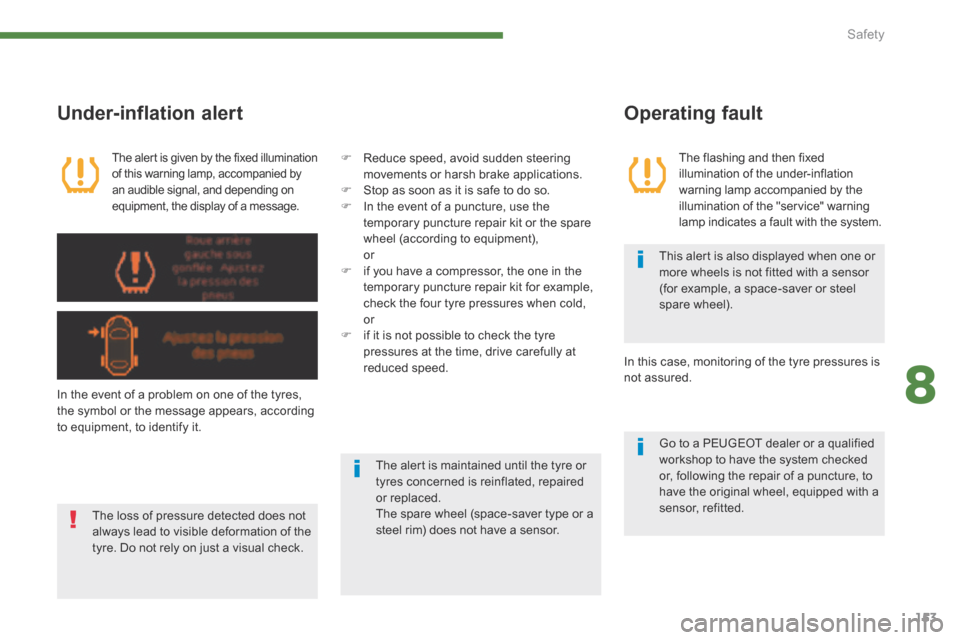
8
Safety153
Under-inflation alert
The alert is given by the fixed illumination of this warning lamp, accompanied by an audible signal, and depending on equipment, the display of a message.
In the event of a problem on one of the tyres, the symbol or the message appears, according to equipment, to identify it.
Reduce speed, avoid sudden steering movements or harsh brake applications. Stop as soon as it is safe to do so. In the event of a puncture, use the temporary puncture repair kit or the spare wheel (according to equipment), or if you have a compressor, the one in the temporary puncture repair kit for example, check the four tyre pressures when cold, or if it is not possible to check the tyre pressures at the time, drive carefully at reduced speed.
The loss of pressure detected does not always lead to visible deformation of the tyre. Do not rely on just a visual check.
The alert is maintained until the tyre or tyres concerned is reinflated, repaired or replaced. The spare wheel (space-saver type or a steel rim) does not have a sensor.
This alert is also displayed when one or more wheels is not fitted with a sensor (for example, a space-saver or steel spare wheel).
Operating fault
The flashing and then fixed illumination of the under-inflation warning lamp accompanied by the illumination of the "service" warning lamp indicates a fault with the system.
Go to a PEUGEOT dealer or a qualified workshop to have the system checked or, following the repair of a puncture, to have the original wheel, equipped with a sensor, refitted.
In this case, monitoring of the tyre pressures is not assured.
Page 156 of 378

Safety
154
Electronic stability control (ESC)
Definitions
Anti-slip regulation (ASR)
The ASR system (also known as Traction Control) optimises traction in order to limit wheel slip by acting on the brakes of the driving wheels and on the engine. It also improves the directional stability of the vehicle on acceleration.
Dynamic stability control (DSC)
If there is a difference between the path followed by the vehicle and that required by the driver, the DSC monitors each wheel and automatically acts on the brake of one or more wheels and on the engine to return the vehicle to the required path, within the limits of the laws of physics.
Emergency braking assistance
In an emergency, this system enables you to reach the optimum braking pressure more quickly and therefore reduce the stopping distance. It is triggered according to the speed at which the brake pedal is pressed. This is felt by a reduction in the resistance of the pedal and an increase in the effectiveness of the braking.
Anti-lock braking system (ABS) and electronic brake force distribution (EBFD)
This system improves the stability and manoeuvrability of your vehicle when braking and provides improved control in corners, in particular on poor or slippery road sur faces. The ABS prevents wheel lock in the event of emergency braking. The electronic brake force distribution system
manages the braking pressure wheel by wheel.
Electronic Stability Control (ESC) incorporating the following systems: - the anti-lock braking system (ABS) and the electronic brake force distribution (EBFD), - the emergency braking assistance, - the anti-slip regulation (ASR) or traction control, - the dynamic stability control (DSC).
Page 157 of 378
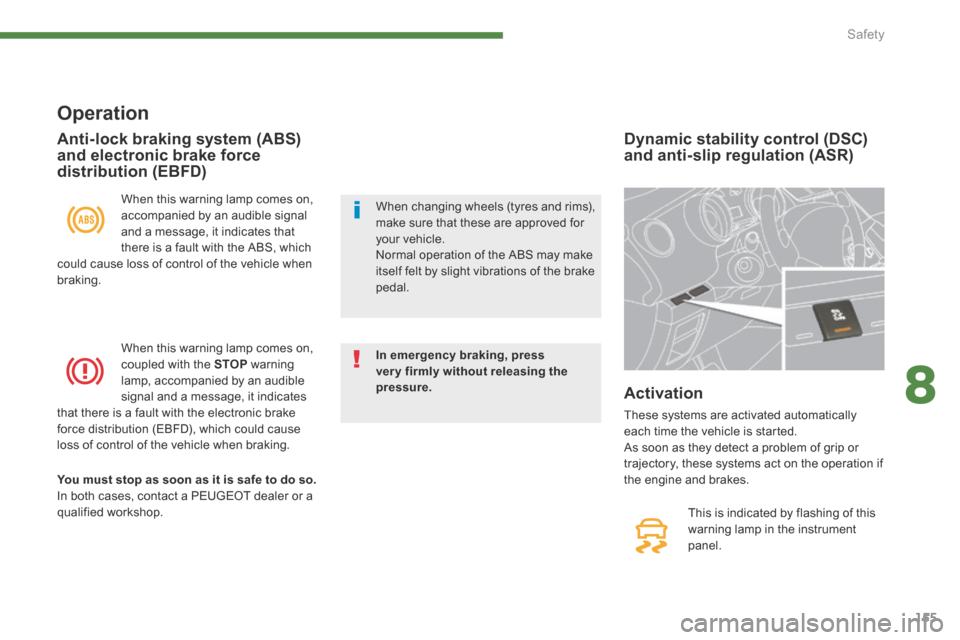
8
Safety155
Dynamic stability control (DSC) and anti-slip regulation (ASR)
This is indicated by flashing of this warning lamp in the instrument panel.
Activation
These systems are activated automatically each time the vehicle is started. As soon as they detect a problem of grip or trajectory, these systems act on the operation if the engine and brakes.
Operation
When this warning lamp comes on, accompanied by an audible signal and a message, it indicates that there is a fault with the ABS, which could cause loss of control of the vehicle when braking.
When this warning lamp comes on, coupled with the STOP warning lamp, accompanied by an audible signal and a message, it indicates that there is a fault with the electronic brake force distribution (EBFD), which could cause loss of control of the vehicle when braking.
You must stop as soon as it is safe to do so. In both cases, contact a PEUGEOT dealer or a qualified workshop.
Anti-lock braking system (ABS) and electronic brake force distribution (EBFD)
In emergency braking, press very firmly without releasing the pressure.
When changing wheels (tyres and rims), make sure that these are approved for your vehicle. Normal operation of the ABS may make itself felt by slight vibrations of the brake pedal.
Page 166 of 378
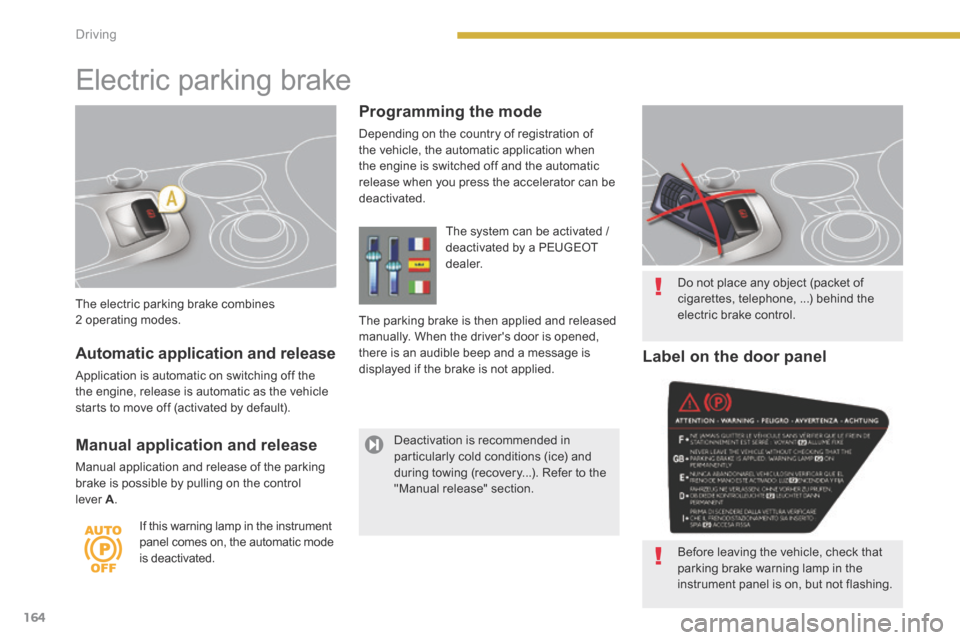
164Driving
The electric parking brake combines 2 operating modes.
Electric parking brake
Programming the mode
Depending on the country of registration of the vehicle, the automatic application when the engine is switched off and the automatic release when you press the accelerator can be deactivated.
If this warning lamp in the instrument panel comes on, the automatic mode is deactivated.
The system can be activated / deactivated by a PEUGEOT dealer.
The parking brake is then applied and released manually. When the driver's door is opened, there is an audible beep and a message is displayed if the brake is not applied. Automatic application and release
Application is automatic on switching off the the engine, release is automatic as the vehicle starts to move off (activated by default).
Manual application and release
Manual application and release of the parking brake is possible by pulling on the control lever A .
Label on the door panel
Do not place any object (packet of cigarettes, telephone, ...) behind the electric brake control.
Deactivation is recommended in particularly cold conditions (ice) and during towing (recovery...). Refer to the "Manual release" section.
Before leaving the vehicle, check that parking brake warning lamp in the instrument panel is on, but not flashing.
Page 167 of 378
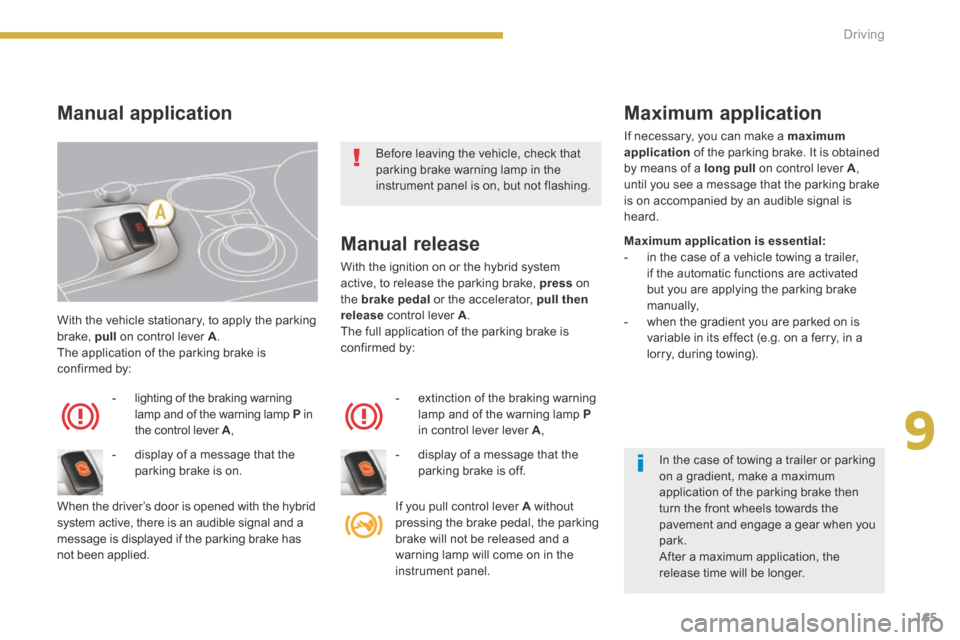
9
165
Driving
With the vehicle stationary, to apply the parking brake, pull on control lever A . The application of the parking brake is confirmed by:
- lighting of the braking warning lamp and of the warning lamp P in
the control lever A ,
When the driver’s door is opened with the hybrid system active, there is an audible signal and a
message is displayed if the parking brake has not been applied.
Manual release
With the ignition on or the hybrid system active, to release the parking brake, press on the brake pedal or the accelerator, pull then release control lever A . The full application of the parking brake is confirmed by:
- extinction of the braking warning lamp and of the warning lamp P
in control lever lever A ,
If you pull control lever A If you pull control lever A If you pull control lever without pressing the brake pedal, the parking
brake will not be released and a warning lamp will come on in the instrument panel.
Manual application Maximum application
If necessary, you can make a maximum application of the parking brake. It is obtained by means of a long pull on control lever A , until you see a message that the parking brake is on accompanied by an audible signal is heard.
Maximum application is essential: - in the case of a vehicle towing a trailer, if the automatic functions are activated but you are applying the parking brake manually, - when the gradient you are parked on is variable in its effect (e.g. on a ferry, in a lorry, during towing).
- display of a message that the parking brake is on. - display of a message that the parking brake is off.
Before leaving the vehicle, check that parking brake warning lamp in the instrument panel is on, but not flashing.
In the case of towing a trailer or parking on a gradient, make a maximum application of the parking brake then turn the front wheels towards the pavement and engage a gear when you park. After a maximum application, the release time will be longer.
Page 168 of 378
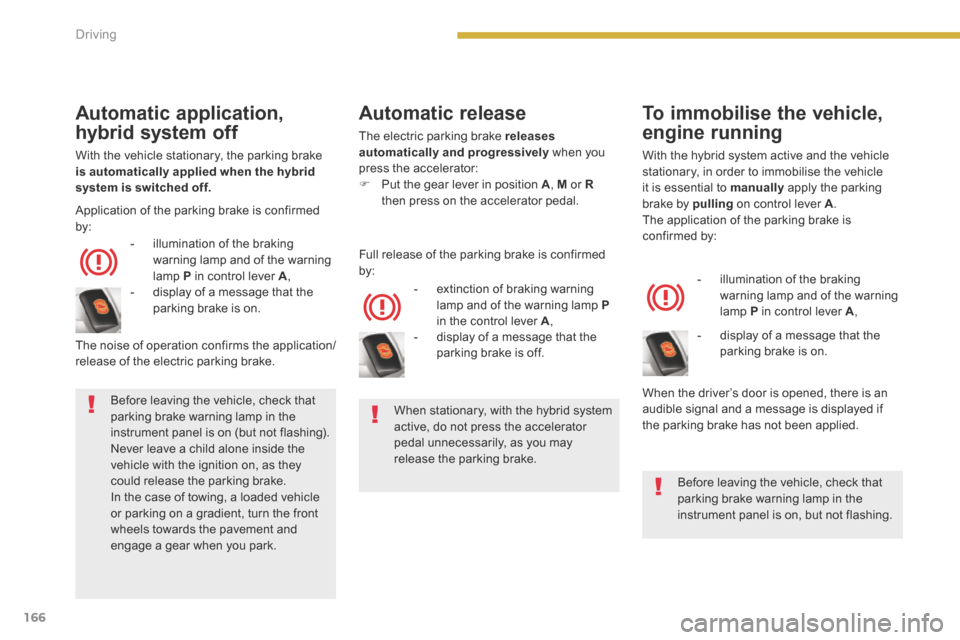
166Driving
Automatic application,
hybrid system off
With the vehicle stationary, the parking brake is automatically applied when the hybrid system is switched off.
- illumination of the braking warning lamp and of the warning lamp P in control lever A ,
Automatic release
The electric parking brake releases automatically and progressively when you press the accelerator: Put the gear lever in position A , M or Rthen press on the accelerator pedal.
- extinction of braking warning lamp and of the warning lamp Pin the control lever A ,
The noise of operation confirms the application/ release of the electric parking brake.
Full release of the parking brake is confirmed by:
To immobilise the vehicle,
engine running
With the hybrid system active and the vehicle stationary, in order to immobilise the vehicle it is essential to manually apply the parking brake by pulling on control lever A . The application of the parking brake is confirmed by:
- illumination of the braking warning lamp and of the warning lamp P in control lever A ,
When the driver’s door is opened, there is an audible signal and a message is displayed if the parking brake has not been applied.
Application of the parking brake is confirmed
by:
- display of a message that the parking brake is on.
- display of a message that the parking brake is off.
- display of a message that the parking brake is on.
Before leaving the vehicle, check that parking brake warning lamp in the instrument panel is on (but not flashing). Never leave a child alone inside the vehicle with the ignition on, as they could release the parking brake. In the case of towing, a loaded vehicle or parking on a gradient, turn the front wheels towards the pavement and engage a gear when you park.
When stationary, with the hybrid system active, do not press the accelerator pedal unnecessarily, as you may release the parking brake.
Before leaving the vehicle, check that parking brake warning lamp in the instrument panel is on, but not flashing.
Page 169 of 378
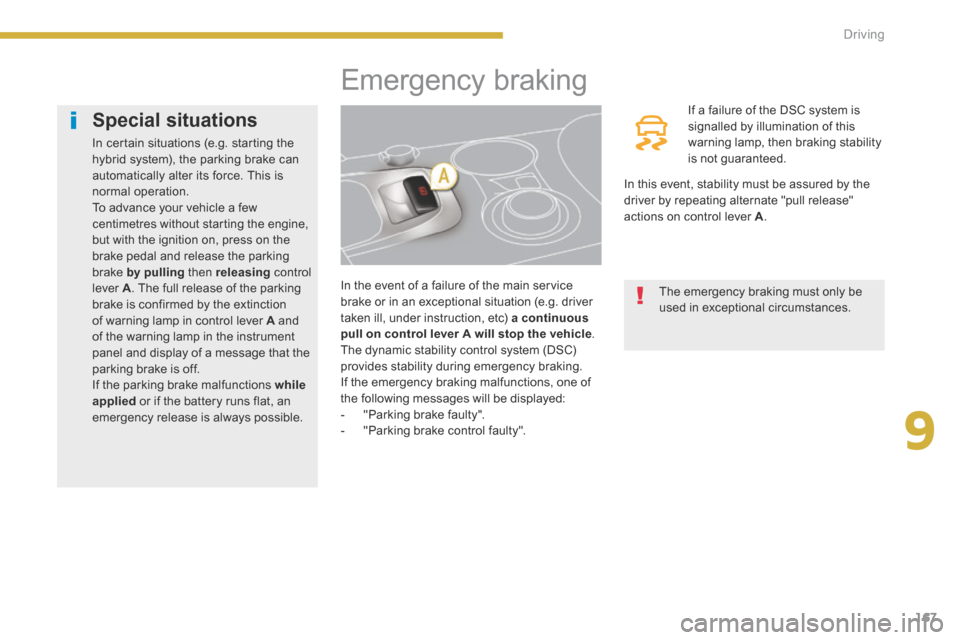
9
167
Driving
Emergency braking
In the event of a failure of the main service brake or in an exceptional situation (e.g. driver taken ill, under instruction, etc) a continuous pull on control lever pull on control lever pull on control leverA will stop the vehicle . The dynamic stability control system (DSC) provides stability during emergency braking. If the emergency braking malfunctions, one of the following messages will be displayed: - "Parking brake faulty". - "Parking brake control faulty".
If a failure of the DSC system is signalled by illumination of this warning lamp, then braking stability is not guaranteed.
In this event, stability must be assured by the driver by repeating alternate "pull release" actions on control lever A .
The emergency braking must only be used in exceptional circumstances.
Special situations
In certain situations (e.g. starting the hybrid system), the parking brake can automatically alter its force. This is normal operation. To advance your vehicle a few centimetres without starting the engine, but with the ignition on, press on the brake pedal and release the parking brake by pulling then releasing control lever A . The full release of the parking brake is confirmed by the extinction of warning lamp in control lever A and of the warning lamp in the instrument panel and display of a message that the parking brake is off. If the parking brake malfunctions while applied or if the battery runs flat, an emergency release is always possible.
Page 170 of 378
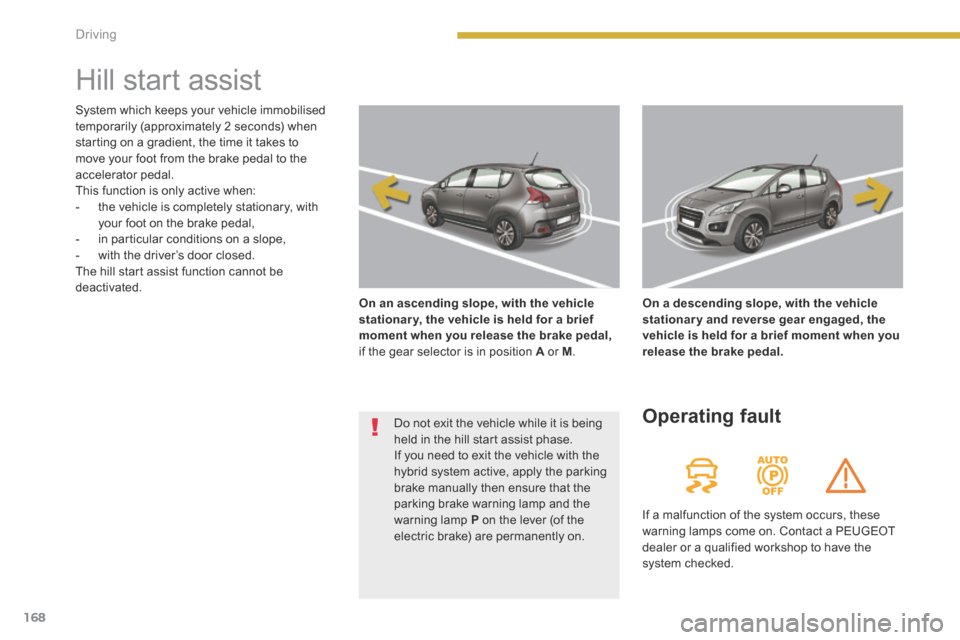
168Driving
Hill start assist
On an ascending slope, with the vehicle stationar y, the vehicle is held for a brief moment when you release the brake pedal,if the gear selector is in position A or M .
On a descending slope, with the vehicle stationary and reverse gear engaged, the vehicle is held for a brief moment when you release the brake pedal.
Operating fault
If a malfunction of the system occurs, these warning lamps come on. Contact a PEUGEOT dealer or a qualified workshop to have the system checked.
System which keeps your vehicle immobilised temporarily (approximately 2 seconds) when starting on a gradient, the time it takes to move your foot from the brake pedal to the accelerator pedal. This function is only active when: - the vehicle is completely stationary, with your foot on the brake pedal, - in particular conditions on a slope, - with the driver’s door closed. The hill start assist function cannot be deactivated.
Do not exit the vehicle while it is being
held in the hill start assist phase. If you need to exit the vehicle with the hybrid system active, apply the parking brake manually then ensure that the parking brake warning lamp and the warning lamp P on the lever (of the electric brake) are permanently on.